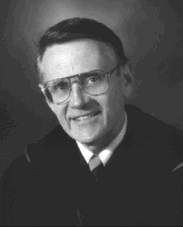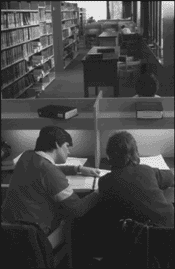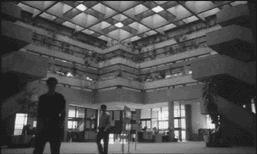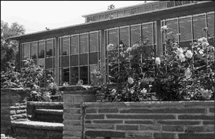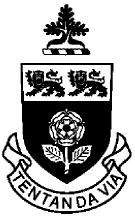
|

|
|
|
|
| | VOLUME 29, NUMBER 27 | WEDNESDAY, APRIL 7, 1999 | ISSN 1199-5246 | | |
|
|
||||||||||||||||||||||||||||||||||||
|
|
By Michael Todd ACTIVISM, ART, POLITICS AND... PEARL JAM. In the March issue of Interview Eddie Vedder, lead singer for the rock band Pearl Jam, and Howard Zinn, a retired Boston University historian, discuss activism, art and politics. The two met last year, after Vedder, who was a fan of Zinn's 1980 book A People's History of the United States, (Harper Perennial Library), invited the author to attend a Pearl Jam concert in Los Angeles. Both men, who say they've lived through their own periods of financial hardship, are troubled by a system that allows those with money to buy influence. Zinn says that although politics is "corrupt and awful," a number of people are working through the system to improve society. And little by little, they're making an impact, he says. He praises artists like Vedder, who has held numerous benefit concerts and has pushed for better education programs in his home state of Washington. Says Zinn: "I come across an artist who is a little more than an artist, who doesn't just do the art but really thinks about the world outside, to me that is a great blessing."
PINT SIZE. John Moores University in Liverpool, England, takes an unusual stance toward drinking for a higher education institution. "You may be forgiven for thinking that drinking is the city's only pastime," reads the university's brochure. "It's not, but there's a lot of opportunity to practise if it's yours." The brochure adds that Liverpool's compact city centre "makes staggering from bar to bar a very pleasurable experience." (Source: Newsweek http://www.newsweek.com 3/1/99.)
GO FIGURE: WHY I LOVE MATH, AND YOU SHOULD TOO. In the spring issue of McSweeney's, Paul DuChateau, a professor of mathematics at Colorado State University, states in an electronic interview that mathematics is "really more about relationships and reasoning than it is about computing." DuChateau, an expert on partial differential equations, attempts to explain his field to non-mathematicians. He relates how people assume that a mathematician would be a good person to prepare their taxes, for example. To understand mathematics, he suggests thinking of it as "a family of languages and none of them really resembles any verbal language." In mathematical language, he explains, "there is no ambiguity; a statement means what it means and that is the only thing it means. There is never any of this 'it depends on what the meaning of IS is.'" The reason most people say they hate math, he says, is that for those who never do graduate work, "the part of mathematics you study is analogous to the 'spelling and grammar' and it's not really interesting except to geeks." Those who continue, he adds, reach another level. "The really interesting part is the part that is analogous to the free expression of ideas in writing." The journal's World-Wide Web address is http://www.mcsweeneys.net
JAPAN CHANGES. In what has been called a sea change for Japan's higher education system, the country's universities are reducing their emphasis on rigorous entrance exams and focusing instead on extracurricular activities and recommendations. The change is welcome news for Japan's high school students, who have traditionally engaged in study marathons to prepare for the nerve-racking exams. Advocates say the change will help end Japan's focus on rote learning and could reinvigorate the country economically. However, critics maintain that turning away from entrance exams could threaten the education system's highly valued egalitarianism. (Source: The Christian Science Monitor http://www.csmonitor.com 3/2/99.)
FIRST WOMEN'S UNIVERSITY IN PAKISTAN. Fatimah Jinnah Women's University in Rawalpindi, Pakistan, opened its doors in December to 355 women students. Pakistan's first university for women, with all-female faculty, staff and students, offers degree programs in business administration, computer science, economics, English, fine arts, and Islamic studies. The institution's vice-chancellor, Najma Najam, hopes to enroll 6,000 students from Asia - primarily from Muslim nations - within the next seven years. Meanwhile, women continue to be barred from Kabul University in Afghanistan, which reopened in March 1997 after being closed for most of the past 15 years because of ongoing warfare. The Islamic fundamentalist group Taliban, which now controls the university, has not allowed the return of 4,000 women who were enrolled as students before it closed. Taliban has also banned hundreds of female professors. Kabul University currently has 160 faculty, down from 900 in the 1970s. (Source: The Chronicle of Higher Education http://chronicle.com 1/15/99.)
GIVING ON THE WEB. A recent study of 60 college and university Web-sites shows that 36 of them (60 per cent) did not provide potential donors with easy access to pertinent information about giving, reports The Chronicle of Higher Education. The study, performed by two graduate students in the philanthropy and development program at Saint Mary's University of Minnesota, found that only 24 of the Web-sites (40 per cent) allowed potential donors to find relevant information about the institution's foundations or development funds with fewer than three clicks of a mouse. (Source: The Chronicle of Higher Education http://chronicle.com 1/29/99.)
|
|||||||||||||||||||||||||||||||||||
|
|
By John M. Goodings and Robert K. Allan It is with great sadness that we report to the York community the death of Professor O. Robert "Bob" Lundell on March 1, 1999 at the age of 67 after a difficult struggle with cancer. A few milestones in Bob's career are worth mentioning before attempting to assess why his impact on York has been so significant. Bob Lundell grew up in Revelstoke, B.C., and was awarded the province-wide British Columbia scholarship to study at Queen's University in Kingston, in 1950. He graduated in 1954 and proceeded to do a PhD degree in physical chemistry at the Massachusetts Institute of Technology which he completed in 1958. His first teaching appointment as a professor of science was at the Royal Military College in Kingston. In 1961, he and his wife Carolyn moved to Toronto when he was appointed as the founding chemistry professor at York University. He was instrumental in hiring Harold I. Schiff from McGill University in 1964 to develop a full science program at York, and served as Harold's associate dean until 1973. At that time, Bob Lundell took over as the second dean of the Faculty of Science, a post which he held with great distinction for ten years until 1982. After a sabbatical leave at Rockwell International in California, Bob returned to York with a primary focus on teaching science. He also served for many years as a member of the Atomic Energy Control Board of Canada. His many contributions as a founder and builder were recognised by York in 1984 with the bestowal of a prestigious University Professorship. One notable contribution was his support of the Centre for Atmospheric Chemistry; he was instrumental in achieving its endowment of the Rogers Chair. He retired from active teaching in 1995. Bob worked hard on the building committee of the new Chemistry and Computer Science Building. One of its lecture halls was officially named the O. Robert Lundell Lecture Theatre at a ceremony held in 1996. The impact of Bob Lundell was felt by many of us primarily in the two areas of teaching and administration. It is worthwhile to try to understand why his influence was so great. Essentially all the people who knew him reach for the same words in describing Bob Lundell: integrity, high standards and a true gentleman. Those words of themselves are admirable, but his effectiveness derived from the fact that he coupled these attributes with an over-riding personal warmth towards all the people around him: colleagues, staff and students. Bob could be testy on occasion, usually if circumstances were forcing him to compromise his sense of what was right and proper. He could be tough if the situation warranted it, but the warmth of his personality invariably removed the sting from his remarks. A petition to Bob Lundell when he was dean, was certain to have a proper hearing. Even if it was not granted, the petitioner left with the knowledge that the matter had been considered carefully and that the decision had been rendered with absolute fairness. In all these matters, he showed great good sense, sound judgement and amazing vision about the consequences for York University. Bob Lundell had a passion for teaching at which he excelled. The beneficiaries were not only his students, but his colleagues as well. He had a deep intellectual love of thermodynamics, the science of how energy interacts with material substances. More than two thousand former undergraduates have benefitted enormously from hearing Bob talk about thermodynamics. To him, it was more than a scientific discipline. It represented an intellectual approach; that is, a way to think about things in general. This is what he tried to convey to his students. For Bob, thermodynamics supplied a pattern for living his life. Thermodynamics is a subtle subject based on three laws of nature. Bob's remarkable success as an administrator and leader was similarly based on a number of "laws" or precepts in which he put great store. Objectivity is paramount. Never confuse strategy with tactics. Don't argue about fact. Think before you speak. But these hard-headed principles were applied with sensitivity, warmth and much good humour. Many of us learned a great deal from him. Not the least of his legacies resides in his three children, Liz, Jennifer and David, all of whom have earned at least one degree from York. We shall miss Bob Lundell, and we shall remember him. John Goodings and Robert Allan are professors in the Department of Chemistry, and close friends of Robert Lundell.
|
|||||||||||||||||||||||||||||||||||
|
|
York University President Lorna Marsden said she was pleased to see the prominence given post-secondary education - and the emphasis on innovation, quality and excellence - in the Ontario Jobs and Investment Board's (OJIB's) "Road Map to Prosperity", released on March 25, 1999. Marsden said she is looking forward to seeing how these ideals will be implemented in the government's upcoming Speech From the Throne and spring budget. York is already well on its way to meeting many of the 21 priorities listed in the OJIB report, especially in relation to the call for innovation which is York's trademark.
For example, York is tapping the best potential from new technology by enhancing distance/
York is also leading the way in another OJIB priority - innovative and flexible education and training delivery systems - or more simply put, combining college and university studies. York has 56 separate arrangements with community colleges in Ontario. Recent joint programs include a York University/ In planning for its - and students' - futures, York is working to ensure that every grade 9 student who wants to go to university can be accommodated if they have the appropriate academic standing. To do that, and to meet OJIB's objectives, we must begin immediately to expand and improve our physical plant and seek support to hire the faculty needed to deliver the high-quality, world-class education that the OJIB report is calling for, said Marsden. That can only be done by keeping watch over the critical importance of balancing support for research and teaching, adding that at York the two are inseparable. "York University is fully committed to providing an innovative environment and relevant programs for the education and training of Ontario citizens," said Marsden. "As York celebrates its fortieth anniversary, we are proud to say that innovation is our tradition. We look forward to working with OJIB, the government, the private sector and other educational institutions in designing and delivering the new education, training and research programs which will be required to prepare the citizens of Ontario for work in the new millennium."
|
|||||||||||||||||||||||||||||||||||
|
|
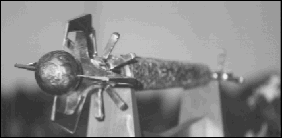
The York University Mace
The mace is carried by the University Beadle at convocation, and was a gift to York University from the City of Toronto in 1964. Rendered in brass, the end section is set with stones of cullet, bloodstone, agate and amazonite, which represent the multicultural makeup of Canada's population. The shoulder has ten projections representing Canada's provinces. The four arms at the head of the mace represent the paths which lead to the ideals that humans
|
|||||||||||||||||||||||||||||||||||
|
|
On Friday, Dec. 4, 1998, the Senate Library Committee, Senate Committee on Research and the York University Libraries co-sponsored a session to inform faculty about the problems fuelling the serials crisis, and initiatives to combat soaring prices. The event was moderated by Professor K. G. Davey, co-editor, Canadian Journal of Zoology and former vice-president (Academic Affairs). Participants heard presentations from Mr. Warren Holder, Electronic Resources Co-ordinator, Robarts Library (University of Toronto) on Publisher Pricing Objectives and the Role of Consortia in Obtaining Better Journal Pricing; Dr. Michael Owen, incoming vice-president (Research & Dissemination), Humanities & Social Sciences Federation of Canada, on A National E-Archives for Scholarship in the Humanities and Social Sciences; and Ms. Ellen Hoffmann, associate vice-president (Academic Information Services ) & University Librarian, York University, on Emerging Alternatives in Scholarly Communication. The presentations were followed by a panel discussion between the presenters and York faculty J. Buzacott, G. Darroch, J. McCamus and S. Saleuddin, all current or former journal editors, in which the themes presented by the experts were explored. Despite the different perspectives and expertise of each of the participants, a number of common themes emerged. Is the present system sustainable? In his opening remarks, Davey cited a prescient publication - Little Science, Big Science - and Beyond, by Derek J. de Solla Price - published more than 30 years previously, in which the author had already identified the exponential growth of scientific journals and had predicted that their number would rise to a million by the millennium. De Solla Price also predicted that this exponential growth would give way to instability: "The outcome of the battle is complete reorganisation or violent fluctuation, or death of the variable (where the variable is the number of journals). If we expect to discourse in scientific style about science and to plan accordingly, we shall have to call this approaching period 'new science' or 'stable saturation'. If we have no such hopes, we must call it senility".
Davey observed that in general, scientists do not rely on journals for immediate communication with colleagues, but that journals do serve three very important purposes. First, they establish priority; second, since they are peer-reviewed, they help to validate the academic endeavour; and third, they are an important form of communication of the record of past scholarship to future generations. Hoffmann's presentation echoed these sentiments. Noting that faculty and librarians share an interest in broad dissemination of academic information, she considered it vital that academic institutions continue to be able to make research widely known, so that it would be valued by society and could continue to be funded. In her estimation, the system, as currently constituted, was not sustainable. While costs continued to rise, the amount which could be purchased with the dollars available continued to decline. This meant that even if universities were to increase funding to library collections, costs would continue to escalate sharply and access to information would be increasingly restricted by a reduction in outlets and a shrinking audience. Hoffmann observed that librarians had been unable on their own to reduce escalating costs, despite attempts (cancelling journal subscriptions, expanding resource-sharing agreements and forming buying consortia). Noting that the current problem in scholarly communication had taken some time to develop, she felt that changing the situation was also likely to take time. This change would require the participation of librarians and academics alike, propelled by their common interest in fostering the broad dissemination of published information. Are electronic journals the solution to rising costs? Much of the session was focussed on the role electronic journals might play in changing access to information, and on some potential benefits and drawbacks of digital formats:
Davey briefly described the National Research Council (NRC) Reseach Press Journals Program, housed within the Canadian Institute for Scientific and Technical Information (CISTI) branch of the National Research Council. The program comprises 14 scientific journals, all of which have been moving aggressively into the electronic age and are now available either on the World Wide Web or on CD-ROM either exclusively, or in addition to print format. He also noted that a number of these journals had already moved to electronic submission and review, which had speeded up the publication process considerably, and he expected that over the next year and a half NRC would be moving all of its journals to electronic submission, review and preliminary editorial process. Michael Owen outlined the Humanities and Social Sciences Federation of Canada (HSSFC) research project (funded by SSHRC) to study the feasibility of a national electronic archive for all electronically published manuscripts and scholarly works by humanists and social scientists in Canada. Whether published in Canada or elsewhere, these scholarly works would be permanently retained and made accessible to the public and scholars, and all materials would be indexed and searchable. The proposal was designed to answer concerns raised by scholars and librarians about the permanence of e-published work, to determine how e-published scholarship can be made more accessible to scholars, and to address issues related to the translation of e-published works from one technological platform to another. Although the gathering agreed that electronic journals and formats were not a panacea, there was a lively discussion on ways to keep costs down and to use electronic formats to pressure commercial publishers to provide cheaper, broader access to their products. A number of participants considered that publishers must resolve the "ownership of information" question in a way which is beneficial to institutions. Currently for most licenced items, ownership of the material is retained by the publisher and the institution's access to the information expires when the licence expires. What alternatives are being developed which can change scholarly communication? A key issue in the view of many of those present was the role of commercial publishers and not-for-profit publishers in bringing the control over scholarly communication back into the academy. McCamus described one possible model - the non-profit structure of law school journals, in which much of the work was done by senior students under the direction of faculty (all volunteers), and most of the revenue was generated by subscriptions. Others described the emergence of voluntary "codes of ethics", in which faculty would only act as reviewers or submit papers to journals whose profits fell within a certain, reasonable, margin. Hoffmann described two key emerging alternatives: the Scholarly Production and Academic Resources Coalition (SPARC), and the National Digital Library Initiative. An initiative of the Association of Research Libraries, SPARC's goals are threefold: to create a more competitive scholarly communication marketplace in which the cost of journals acquisition and archiving and information access are reduced; to use new technology to improve the process of scholarly communication and reduce the cost of production and distribution; and to give greater meaning to the privileges of authorship. Hoffmann noted that the first products of SPARC were just being announced. Three of the SPARC-sponsored journals were designed to compete directly with existing, and very costly, journals. One of these new initiatives - PhysChemComm, currently costing $350 per year - provides competition for the existing Chemical Physics, whose subscriptions currently cost approximately $8,000 annually. The benefits of these new journals, aside from reduced subscription costs, are the reduced time from submission of manuscripts to published product, and the increased illustrative capabilities of electronic media.
SPARC also aims to provide aid to existing qualified titles and to encourage submissions to electronic journals, in both cases to encourage competition in the journal marketplace. The Canadian Fund for Innovation has invited the library community to make a proposal for a National Digital Library. The objectives of this initiative would be to test the national site licence concept for electronic journals, to establish an effective management structure, and to develop a sustainable economic model. Twenty million dollars has been earmarked for this initiative provided the university library community can match that amount with 30 million dollars. At the conclusion of the presentations and general discussion (including questions and observations from the audience), members of York's student Debating Team - Marion Cronin, Vas Eleftheriadis, Jennifer Georgeff, Helen Kim, Vijay Sarma and David Zic - treated the audience to a lively debate on the question : Should authors publish in electronic journals?
For more information, contact Susan Eastwood at extension 40058 or e-mail eastwood@yorku.ca.
|
|||||||||||||||||||||||||||||||||||
|
|
York University's first intercollegiate basketball team, 1962-1963
|
|||||||||||||||||||||||||||||||||||
|
|
By Paul Delaney Lights ... The increasing problem of light pollution is a topic which is near and dear to my heart but one which, I often feel, is not discussed by many folks. It is a problem that affects us all in one way or another and it certainly impacts on the environmental legacy we will leave the next generation. As I was driving home tonight from York University, I was dismayed (appalled) by the increase in illumination that was occurring. Brand new parking lot floodlights (security lights?) had been installed within a few hundred metres of the observatory, to the north and west. Searchlight beams now pierce the sky from cinema complexes, interfering with almost every aspect of astronomical endeavor. However, despite my unhappy observations, it does seem that more and more people are becoming aware of the problem and are prepared to do their bit in improving the general state of the night sky. For example, the Town of Richmond Hill has long protected the David Dunlop Observatory with good light pollution bi-laws that have not caused a decrease in public safety yet have succeeded in protecting the quality of the night sky (to some extent at least) for all of us. Articles have appeared in many municipal newspapers indicating a real concern about ad hoc lighting standards being adopted by various town planners and lighting engineers. In fact, the various professional bodies under whose mandate it is to inform politicians of what constitutes suitable lighting standards, are seriously examining full cut-off lighting standards (at last!). Locally though, what 'standards' do Toronto and Vaughan follow for outdoor lighting? Have the cities adopted horizontal and vertical luminance standards in accord with, say the Town of Richmond Hill? Are the new light fixtures installed by the two cities of the full cutoff variety to ensure the maximum amount of light is projected onto the ground (where it is (presumably) needed)? Is the uniformity ratio in the effected area better than 4:1 to ensure no checkerboard pattern of dark and hot spots? Is light trespass considered enforceable by the police? I have seen little evidence that such quality lighting standards exist or are enforced in our area. The net effect of not having a clear lighting standard is brighter lights than necessary that disturb an individuals dark adaptation making it less safe to operate in the affected area. There is even increasing evidence that too much night-light increases an individual's susceptibility to cancer! Some years ago York University commenced a program of improving the intensity level in all its parking lots to allow for television surveillance. Despite the fact that a 10 fold increase in light intensity has occurred on the ground, no additional light is being directed above the horizontal plane, protecting the skies above York and ensuring that everyone's dark adaptation and personal safety is improved. After midnight, some of the lights are turned off to save on the electricity bill but still leaving an adequate level of illumination. In general, artificial illumination directed skywards is obnoxious as it scatters off gas molecules and dust particles in the air and creates the gray background that makes star gazing difficult. Such lighting is also an enormous waste of energy (and money). If all of the illumination from a light were aimed at the ground, the intensity of the light bulb would not have to be as high to produce the desired levels of ground illumination. This would mean a more economical light to operate that would not need replacing (or repairing) as often and of course such a light would be more environment friendly (less coal, oil or uranium consumed). Such a light is easily created by a better-designed shield over the bulb itself. Further, better-shielded light fixtures would be less offensive to the eye, creating less disability glare, causing the eye not to dilate and become less dark sensitive. How many of you appreciate looking at the high beams of oncoming traffic when the vehicles low beams give sufficient warning of its presence? In short, bigger and brighter light fixtures are not better nor more effective in achieving the aims of personal and property security. One of the joys of the country is the quality of sky we can enjoy. This is steadily being eroded by poorly shielded street lights and building security lights. We will all 'see' the rewards of such planning by observing the stars.
Paul Delaney is a senior lecturer in physics and astronomy, and Master of Bethune College. |
|||||||||||||||||||||||||||||||||||
|
|
A white rose by any other name: Revealed at last - the wellspring of the name, York University By John Court In my March 24th article on York's charter legislation and a companion piece on the founding era in Profiles it was noted that this University acquired its name from the YMCA Organizing Committee, beginning early in 1958. We have since learned via Alan Clarke (Hon. LL.D. 1992), the committee's secretary and evidently its last surviving member, that the York name was put forward at that time by Moffatt Woodside, then Acting President of the University of Toronto. Moffatt St. Andrew Woodside (1906-1970) was a distinguished classicist and antiquarian scholar from Carleton Place and Brantford, Ontario who spent a thorough and productive life at the downtown university, interrupted only by his Rhodes Scholarship sojourn at Oxford and then Harvard. Along with sound scholarship he is remembered at Oxford for flouting the males-only exclusivity of Corpus Christi College by inviting the entire 70 women members of the D'Oyly Carte Opera Company to a cast party in his rooms. In February of 1958, when the Organizing Committee held a series of "Round Table" consultations at the Granite Club to solicit advice from elite representatives of organizations with related interests, "Moff" was invited as the Acting President of U of T. Along with matters of philosophy and substance, the organizers had grappled for two years with various pragmatics, and were now seeking outside wisdom on both types of issues.
One practical matter was a suitable name that would give the proposed new institution a recognizable public identity with which to move forward. Suggestions had been narrowed to a proposed tribute to the founder of their North Toronto YMCA sponsors, Mr. Justice Kellock. By late 1957 this idea had evolved from "The Kellock Institute" to Kellock College, later to become Kellock University, following the pattern set by Canada's other "Y" university colleges, Carleton and Sir George Williams. At one Round Table session Moff Woodside, supported by Dr. J.A. Gibson, dean of Arts and Sciences at Carleton (named for its Carleton County location), counseled against naming this or any institution after a person. As we reflect now on that advice, the namesakes of most such examples, however meritorious, have fallen into the realm of historical esoterica: Sir George Williams (19th century British founder of the "Y" movement), McMaster, Dalhousie, McGill and so forth. Brock University in St. Catharines, honouring "the saviour of Upper Canada," is perhaps an exception that proves the rule. "Academies should always be named after their locale," Woodside urged. "The truly great universities like Oxford and Cambridge have taken root in the ground - territory, rather than people's names - so here's a suggestion: York." This was clearly an inspired idea: not just any locale, but the early British-Canadian geographic place name of both of our main campuses and the downtown Schulich annex - York Township and York County, established as concentric rings around the Town of York from 1793. (North York and East York, lately submerged in the megacity, were partitioned off from York Township in 1922. York County beyond the megacity is now York Region.) The Organizing Committee immediately took to Woodside's suggestion. The Chairman, Air Marshall Wilfred Curtis remarked lightly that it rang true for him as a member of the York Club. He noted that the club motto (carved on the chair backs) was taken from Lieutenant-Governor John Graves Simcoe's legendary declaration on arriving here by ship from Niagara-on-the-Lake in 1793 to establish the provincial capital: "Let us harbour here in York." So the name gradually became formalized as it became obvious that it was a good choice. Alan Clarke, as Secretary, noted in a report dated 26 May 1958, endorsed by the Chairman, that "the committee has come to be known as the York University College Committee." Then at a meeting three months later, "Arthur Margison moved and Edgar Alberts seconded a motion [that was carried] that the name of the new institution be York University." That name was then used consistently and enshrined in legislation the following year through The York University Act, 1959. Moff Woodside remained a steadfast friend to York's founders, offering further expert advice on at-least one other occasion before a single class was held. As one of its initial decisions the York Board of Governors (BoG) decided to hold a competition among Ontario Grade 13 students of Latin to select the University motto - Wilf Curtis's lighthearted, York Club suggestion having been reluctantly set aside. The fledgling York faculty, however, did not include a classicist (nor from this writer's semi-external vantage point has one appeared since, for reasons both mysterious and illogical for a university striving for greatness). So Woodside was asked to provide the Latin Motto Committee's specialized academic expertise, joined by two York faculty: our first sociology professor, John R. (Jack) Seeley; and the registrar, political science lecturer and soon-to-be hockey coach, Denis Smith. The committee made a progress report to the BoG in May 1960 and by the following month when a decision was made there were more than 200 submissions in all. Woodside identified the selected motto, Tentenda Via, as originating in a passage of Virgil's "Georgics."
John Court, an independent historian and archivist, was a member of York's founding class of 76 students in 1960. For several years, during the 1970s and 1980s, he was a senior legislative policy advisor for the Ontario Government.
|
|||||||||||||||||||||||||||||||||||
|
|
Osaka dancers shine at York
Pictured here to the left of the Osaka students are Vice-President, University Advancement Gary J. Smith, Chancellor Avie Bennet, Mr. Naoji Matsubara, director of the Japan Foundation and Professor Michie Hayaski; in the centre - York Dance Department faculty member Donna Krasnow; and to the right Professor Michiko Ito and York President Lorna Marsden. |
|||||||||||||||||||||||||||||||||||
|
|
Why Work / Walk alone
Why work alone?If you are working alone in a lab, classroom or office, between the hours of 6 p.m. and 7 a.m. or any time on the weekends or holidays, contact Campus Security at extension 58000 or 650-8000 to arrange for periodic checks in person or by telephone. A Security escort can also be arranged for the end of your work period, and a limited number of cellular phones is available from Security Services for free use while working alone on campus. Why walk alone?If you would like an escort to your vehicle, classroom or residence when working on campus off-hours, Student Security Officers will meet you at parking lots, bus stops, buildings and residences; escort you to your destination; and wait with you for buses, cabs, or until your vehicle starts. This complimentary service is provided to the York community by the Department of Safety, Security and Parking. The service operates daily during the academic year (September to April) from 6 p.m. to 2 a.m., and during the summer months from 8 p.m. to 2 a.m. For more information, contact the Student Security Office at (416) 736-5454 or extension 55454 or visit the website at http:\\www.ssp.yorku.ca. EMERGENCY (for the York and Glendon campuses) Call extension 33333 or 736-5333
|
| ||||||||||||||||||||||||||||||||||
|
| Current Issue | Previous Month | Past Issues | Rate Card | Contact Information | Search |
|
